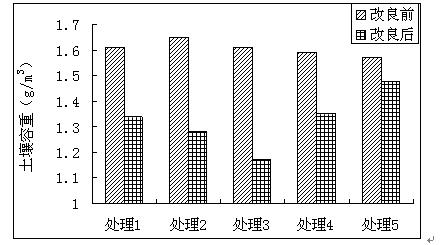Method for improving and greening natural saline soil
A technology of saline soil and loam soil, applied in the field of ecological restoration technology and application, can solve the problems of land resource destruction, unfavorable sustainable development of ecological environment, high cost of guest soil greening, etc.
- Summary
- Abstract
- Description
- Claims
- Application Information
AI Technical Summary
Problems solved by technology
Method used
Image
Examples
Embodiment 1
[0070] (1) Lay concealed pipes at a depth of 60cm in the light loamy soil test site with a distance of 5m. The flat land is divided into plots with a width of 5m and a length of 10m. Field ridges with a height of 0.5m and a width of 0.5m are set between each plot Prevent lateral seepage; then pour 5g / L salt water in each plot, 1000m each time 3 / hm 2 , deep plowing before the rainy season (depth is 40cm) after 2 times, and adding 150m of corn stalks at the same time 3 / hm 2
[0071] (2) After filling with salt water twice, apply improver I 5000kg / hm after plowing each plot 2 ; The number of parts by weight of the modifier I component is superphosphate: organic fertilizer: desulfurized gypsum=1:1:3;
[0072] (3) Use the natural rainfall in the rainy season to wash the soil and measure the changes in soil physical and chemical properties.
[0073] The results of the measurement show that: the salt content of the 0-60cm soil dropped from the original 12.56g / kg to 4.35g / kg, t...
Embodiment 2
[0077] (1) Lay concealed pipes at a depth of 60cm in the light loamy soil test site with a distance of 5m. The flat land is divided into plots with a width of 5m and a length of 10m. Field ridges with a height of 0.5m and a width of 0.5m are set between each plot Prevent side seepage; then pour 8g / L salt water in each plot, 1200m each time 3 / hm 2 , deep plowing before the rainy season (depth is 60cm) and adding 100m of corn stalks at the same time 3 / hm 2 ;
[0078] (2) Then plow and apply improver II 5000kg / hm in each plot 2 ; The number of parts by weight of the modifier II component becomes vinegar residue: lignite: desulfurization gypsum=1:2:2;
[0079] (3) Use the natural rainfall in the rainy season to wash the soil and measure the changes in soil physical and chemical properties.
[0080] The results of the measurement show that: the salt content of the 0-60cm soil dropped from the original 13.66g / kg to 3.27g / kg, the soil pH dropped from the original 8.57 to 8.25,...
Embodiment 3
[0084] (1) Lay concealed pipes at a depth of 60cm in the light loamy soil test site with a distance of 5m. The flat land is divided into plots with a width of 5m and a length of 10m. Field ridges with a height of 0.5m and a width of 0.5m are set between each plot Prevent lateral seepage; then pour 6g / L salt water in each plot, 1200m each time 3 / hm 2 , deep plowing before the rainy season (depth is 40cm) after 2 times, and adding 150m of corn stalks at the same time 3 / hm 2 ;
[0085] (2) Then plow and apply Improver II in each plot, 9000kg / hm 2 ; The number of parts by weight of the modifier II component becomes vinegar residue: lignite: desulfurization gypsum=1:2:2;
[0086] (3) Use the natural rainfall in the rainy season to wash the soil and measure the changes in soil physical and chemical properties.
[0087] The results of the measurement show that: the salt content of the 0-60cm soil dropped from the original 14.28g / kg to 3.85g / kg, the soil pH dropped from the ori...
PUM
 Login to View More
Login to View More Abstract
Description
Claims
Application Information
 Login to View More
Login to View More - Generate Ideas
- Intellectual Property
- Life Sciences
- Materials
- Tech Scout
- Unparalleled Data Quality
- Higher Quality Content
- 60% Fewer Hallucinations
Browse by: Latest US Patents, China's latest patents, Technical Efficacy Thesaurus, Application Domain, Technology Topic, Popular Technical Reports.
© 2025 PatSnap. All rights reserved.Legal|Privacy policy|Modern Slavery Act Transparency Statement|Sitemap|About US| Contact US: help@patsnap.com



